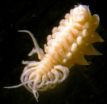(Press-News.org) An invasive insect, hemlock woolly adelgid, has been marching north along the Appalachians, killing almost every hemlock tree in its path. The adelgid has devastated forests in Georgia, Tennessee, and Virginia. The pest recently arrived in Vermont and other parts of New England. So far, only extreme cold stops the adelgid.
But now a University of Vermont scientist has developed what he calls a "fungal microfactory" technology that promises to give forest managers and homeowners a tool to fight back.
Working with the U.S. Forest Service, the State of Vermont, and others, Scott Costa, a UVM entomologist, has combined sweet whey, a byproduct of cheesemaking, with an insect-killing fungus to create an EPA-registered bio-pesticide that, in trials, was able to reduce the pest's growth rate.
In Vermont trees with a high level of infestation, the treatment brought down the population of the adelgid, while in adjacent control trees, that were not treated, the pest population tripled.
This mixture, that Costa calls Mycomax, seems likely to provide cost-effective protection for hemlock trees in native forests as well as landscaping contexts.
In 2009, Costa had success with field trials on one-acre forest plots in Tennessee, using helicopters to drop the fungus mixture into the epicenter of the adelgid's devastating attack. Though no scientists think the pest can be wholly eliminated, these trials reduced the growth rate of adelgid by fifty percent. "That's the first time that's been demonstrated with an insect-killing fungus," Costa says. And slowing the pest's growth seems likely to give trees a fighting chance of recovery.
Over the last year, Costa has been testing the same technology on single trees in Townshend State Park in Vermont to see if ground-based spray applications will work, too. On June 7, 2011, he released a report to the State of Vermont that presents data showing that, "treatment by the fungus suppressed HWA population growth." These results are will also be presented in a forthcoming U.S. Forest Service publication.
The entire range of eastern hemlock and the less common Carolina hemlock, from southern Canada to Georgia, is currently at risk from the adelgid, a bug native to Asia that arrived in the United States in the 1920s and made its way to the East Coast in the 1950s.
The stakes are high: hemlock provides habitat for dozens of mammals and birds. Arching over streams, it creates deep shade critical for the survival of trout and other fish. Some scientists think hemlock is a so-called keystone species, holding up a whole ecosystem.
The fungus Costa is using, lecanicillium muscarium, is native to most parts of the world, including the US. Typically, fungal applications for pest control are used in high-value crops, like those grown in greenhouses, and the fungus is produced in a traditional brick-and-mortar factory and then released in the target location. This approach can be effective, but expensive.
Costa's innovation takes a low-value waste-product, sweet whey, and uses it as a growth medium to promote populations of the fungus out in the natural environment where it is wanted. This has the potential to greatly reduce the cost of treatment and to allow the fungus to self-replicate at significant rates after the initial treatment.
Hemlock is a major tree in Eastern forests; it's the third most common tree species in Vermont. But it could soon drop off the list, going the way of the now-vanished chestnut and elm. Costa's data suggests that there could be a less-bleak future for hemlock trees with help from fungal microfactories.
### END
Forest fungus factory
New technology fights hemlock pest
2011-07-22
ELSE PRESS RELEASES FROM THIS DATE:
Hepatitis C is transmitted by unprotected sex between HIV-infected men
2011-07-22
Sexual transmission of hepatitis C virus (HCV) is considered rare. But a new study by researchers at Mount Sinai School of Medicine, working with the Centers for Disease Control and Prevention (CDC), provides substantial evidence that men with HIV who have sex with other men (MSM) are at increased risk for contracting HCV through sex.
The results of the study are published in today's edition of the CDC's Morbidity and Mortality Weekly Report.
HCV transmission primarily occurs through exposure to blood, and persons who inject drugs at greatest risk. But when Mount Sinai ...
Paternity testing helps fill in family tree for Puget Sound's killer whales
2011-07-22
In a study published online this month in the Journal of Heredity, NOAA researchers and others, using DNA testing to fill in a missing link in the lives of killer whales that seasonally visit Washington's Puget Sound, have discovered that some of the progeny they studied were the result of matings within the same social subgroups, or pods, that are part of the overall population.
One implication of this inbreeding behavior is a significant reduction in the genetic diversity of what is already a perilously small population of animals, formally known as Southern Resident ...
Hospital bacteria outbreak linked to nasal spray
2011-07-22
Chicago, IL—Infection control researchers investigating a rare bacterial outbreak of Burholderia cepacia complex (Bcc) identified contaminated nasal spray as the root cause of the infections, leading to a national recall of the product. An article in the August issue of Infection Control and Hospital Epidemiology, the journal of the Society for Healthcare Epidemiology of America (SHEA), describes how researchers were able to trace the outbreak back to the nasal decongestant spray.
Bcc is a group of Gram-negative bacteria that can cause hard-to-treat infections. Patients ...
Hepatitis B vaccination for health care students lags behind recommendations
2011-07-22
Chicago, IL (July 21, 2011)—A study in the August issue of Infection Control and Hospital Epidemiology, the journal of the Society for Healthcare Epidemiology of America (SHEA), suggests that documentation of hepatitis B vaccination for health care students may fall short of current recommendations.
Researchers led by Dr. Rania Tohme of the Centers for Disease Control and Prevention (CDC) analyzed hepatitis B immunization records of 4,075 health care students who matriculated at a university in the southeastern U.S. between January 2000 and January 2010. The study found ...
1 in 4 gay/lesbian high school students are homeless
2011-07-22
Roughly 1 in 4 lesbian or gay teens and 15 percent of bisexual teens are homeless, versus 3 percent of exclusively heterosexual teens, finds a Children's Hospital Boston study of more than 6,300 Massachusetts public high school students. Moreover, among teens who were homeless, those who were gay, lesbian or bisexual (GLB) were consistently more likely than heterosexuals to be on their own, unaccompanied by a parent or guardian.
The study, published online July 21 by the American Journal of Public Health, is the first to quantify the risk of homelessness among teens ...
A hot species for cool structures
2011-07-22
A fungus that lives at extremely high temperatures could help understand structures within our own cells. Scientists at the European Molecular Biology Laboratory (EMBL) and Heidelberg University, both in Heidelberg, Germany, were the first to sequence and analyse the genome of a heat-loving fungus, and used that information to determine the long sought 3-dimensional structure of the inner ring of the nuclear pore. The study was published today in Cell.
The fungus Chaetomium thermophilum lives in soil, dung and compost heaps, at temperatures up to 60oC. This means its ...
OSC lifts OSU land speed racer toward 400-mph goal
2011-07-22
Building a battery-powered land speed vehicle capable of achieving a speed of 400+ miles per hour requires innovative components, corporate partnerships, hours of diligent preparation and a powerful supercomputer.
A team of engineering students at The Ohio State University's (OSU) Center for Automotive Research (CAR) recently began running aerodynamics simulations at the Ohio Supercomputer Center (OSC), one of the first steps in the long and careful process of researching, designing, building and racing the fourth iteration of their record-breaking, alternative-fuel streamliner. ...
University of Texas faculty bring science and policy to hydraulic fracturing debate
2011-07-22
On July 10, The Denver Post published two side-by-side op-ed pieces on hydraulic fracturing. One by Dave McCurdy, president and CEO of the American Gas Association, argued that the natural gas extraction process has led to an energy revolution in the U.S., one that reduces the nation's dependence on foreign energy, creates domestic jobs and safely helps the nation meet its diverse and growing energy needs while reducing its carbon footprint.
The second piece by Sam Schabacker, a senior organizer for the consumer advocacy organization, Food & Water Watch, paints a different ...
Parasites help reveal new ecological rules
2011-07-22
(Santa Barbara, Calif.) –– Scientists at UC Santa Barbara and other institutions say their new research is expected to profoundly affect the field of ecology and can assist the management of ecosystems, including forests, lakes, and oceans. And it's all because of parasites.
The research, published this week in the journal Science, includes parasites in a comprehensive study of ecosystems. By doing so, the scientists say they have revealed new ecological rules.
"The major finding of our research is that all types of animals –– parasites or otherwise –– appear to follow ...
INFORMS: CARE positions disaster relief with promising discipline of humanitarian logistics
2011-07-22
Operations research models developed by a team at the Georgia Institute of Technology helped CARE International pick three locations worldwide to supply relief quickly to victims of earthquakes, floods, and other natural disasters, according to a paper in a journal of the Institute for Operations Research and the Management Sciences (INFORMS®).
"Pre-Positioning of Emergency Items for CARE International" is by Serhan Duran, currently at the Middle East Technical University in Ankara Turkey, and by Marco A. Gutierrez and Pinar Keskinocak of the H. Milton Stewart School ...
LAST 30 PRESS RELEASES:
Hospitals acquired by real estate investment trusts associated with greater risk of bankruptcy, closure
City of Hope scientists study rare disorder to uncover mechanism and hormone regulation underlying fatty liver disease and sweet aversion
Your genes may influence gut microbiome of others, rat study shows
‘Personality test’ shows how AI chatbots mimic human traits – and how they can be manipulated
Global food systems driving twin crises of obesity and global heating
Osaka Medical and Pharmaceutical University researchers capture real-time molecular movies of enzyme catalysis
Could your genes influence the gut microbiome of others?
Clues to Alzheimer’s disease may be hiding in our ‘junk’ DNA
Study reveals that the body uses different sensors to detect cold in the skin and in internal organs
iPS cells from dish to freezer and back
Deep neural networks enable accurate pricing of American options under stochastic volatility
Collective risk resonance in Chinese stock sectors uncovered through higher-order network analysis
Does CPU impact systemic risk contributions of Chinese sectors? Evidence from mixed frequency methods with asymmetric tail long memory
General intelligence framework to predict virus adaptation based on a genome language model
Antibiotic resistance is ancient, ecological, and deeply connected to human activity, new review shows
Vapes, pouches, heated tobacco, shisha, cigarettes: nicotine in all forms is toxic to the heart and blood vessels
From powder to planet: University of Modena engineers forge a low-carbon future for advanced metal manufacturing
Super strain-resistant superconductors
Pre-school health programme does not improve children’s diet or physical activity, prompting call for policy changes, study finds
Autumn clock change linked to reduction in certain health conditions
AI images of doctors can exaggerate and reinforce existing stereotypes
Where medicine meets melody – how lullabies help babies and parents in intensive care
We may never be able to tell if AI becomes conscious, argues philosopher
AI video translation shows promise but humans still hold the edge
Deep ocean earthquakes drive Southern Ocean’s massive phytoplankton blooms, study finds
Without campus leftovers to pick through, the beaks of this bird changed shape during the pandemic
High-dose antibiotic does not reduce mortality in tuberculous meningitis
How many insects fly in the sky above the USA?
Could cheese protect your brain health?
Who faces more difficulty recovering from stroke?
[Press-News.org] Forest fungus factoryNew technology fights hemlock pest

